期末考试病例分析题
- 格式:docx
- 大小:13.66 KB
- 文档页数:1

班级:________________ 姓名:________________ 学号:________________ _ _ _____ _ _____ _ _____ _ _____ _ _____ _ _____ _ _____ _装_ _ _ _ _订_ _ _ _ _线_ _ _(装订线内禁止填写答案)_ _____ _ _____ _ _____ _ _____ _ _____ _ _____ _ _____ _ _____ _ _____ 一、病例分析(本大题共12小题,12分) 1. 患者女,41岁,右乳腺乳头外上方皮下有肿块,你准备采取哪些方法来确定肿块的性质(包括采集病史,物理检查和病理检查)? 【答案】 ⑴采集病史:发现肿块时间长短,生长快慢,是否疼痛,既往有无特殊病史;⑵体格检查:双侧乳腺是否对称,患者乳腺皮肤、乳头情况,肿块大小、质地、活动度,是否压痛,乳头有无溢液,同侧腋窝和锁骨上淋巴结有无肿大,质地硬度等;⑶乳腺的X 线摄影;⑷穿刺涂片或穿刺活体组织检查:初步确定其性质;⑸活体组织检查:确定肿块性质及肿瘤组织学类型等。
(本小题1分) 2. 患者女性,58岁,已婚。
12岁时反复多次咽喉肿痛后出现膝、距小腿(踝)、腕等大关节游走性疼痛,此种情况曾反复发作多次。
26岁进行婚前体检时,其心尖区闻及收缩期杂音,近5年来在活动后有心悸、气促,近3年病情加重,并有四肢水肿,夜尿,呼吸困难、咳粉红色泡沫痰。
请回答以下问题: (1)患者12岁时患的是什么病?并简述其基本病变。
(2)26岁后患的是什么病?请简述其发展过程及病变,并用器官的病变解释以下临床表现:心悸、气促、咳粉红色泡沫痰、四肢水肿。
【答案】 ⑴风湿性关节炎,病变为Aschoff 小体。
⑵二尖瓣狭窄和关闭不全,伴全心衰竭;病变为瓣膜增厚、变硬、全心肥大、扩张、肺淤血、水肿。
解释:心瓣膜病、心代偿→心悸;左心衰竭、肺淤血、水肿→气促、咳粉红色泡沫痰;右心衰竭→四肢水肿。
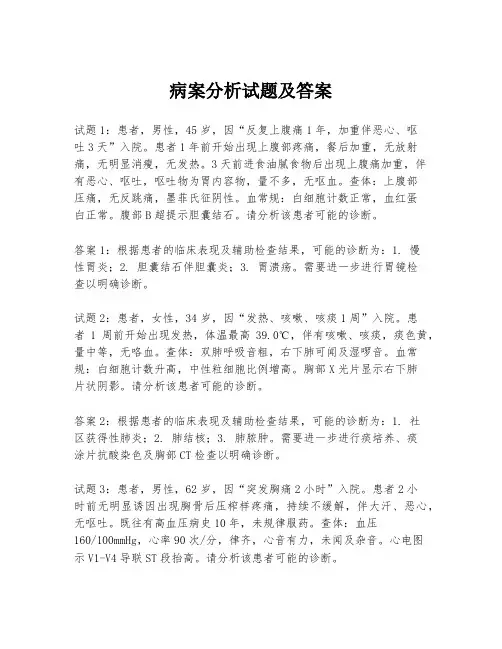
病案分析试题及答案试题1:患者,男性,45岁,因“反复上腹痛1年,加重伴恶心、呕吐3天”入院。
患者1年前开始出现上腹部疼痛,餐后加重,无放射痛,无明显消瘦,无发热。
3天前进食油腻食物后出现上腹痛加重,伴有恶心、呕吐,呕吐物为胃内容物,量不多,无呕血。
查体:上腹部压痛,无反跳痛,墨菲氏征阴性。
血常规:白细胞计数正常,血红蛋白正常。
腹部B超提示胆囊结石。
请分析该患者可能的诊断。
答案1:根据患者的临床表现及辅助检查结果,可能的诊断为:1. 慢性胃炎;2. 胆囊结石伴胆囊炎;3. 胃溃疡。
需要进一步进行胃镜检查以明确诊断。
试题2:患者,女性,34岁,因“发热、咳嗽、咳痰1周”入院。
患者1周前开始出现发热,体温最高39.0℃,伴有咳嗽、咳痰,痰色黄,量中等,无咯血。
查体:双肺呼吸音粗,右下肺可闻及湿啰音。
血常规:白细胞计数升高,中性粒细胞比例增高。
胸部X光片显示右下肺片状阴影。
请分析该患者可能的诊断。
答案2:根据患者的临床表现及辅助检查结果,可能的诊断为:1. 社区获得性肺炎;2. 肺结核;3. 肺脓肿。
需要进一步进行痰培养、痰涂片抗酸染色及胸部CT检查以明确诊断。
试题3:患者,男性,62岁,因“突发胸痛2小时”入院。
患者2小时前无明显诱因出现胸骨后压榨样疼痛,持续不缓解,伴大汗、恶心,无呕吐。
既往有高血压病史10年,未规律服药。
查体:血压160/100mmHg,心率90次/分,律齐,心音有力,未闻及杂音。
心电图示V1-V4导联ST段抬高。
请分析该患者可能的诊断。
答案3:根据患者的临床表现及心电图表现,可能的诊断为:1. 急性前壁心肌梗死;2. 不稳定型心绞痛;3. 急性心包炎。
需要立即给予抗血小板、抗凝治疗,并尽快进行冠状动脉造影检查以明确诊断。
试题4:患者,女性,28岁,因“停经40天,下腹痛伴阴道流血1天”入院。
患者平素月经规律,周期30天,末次月经40天前。
1天前出现下腹痛,为阵发性疼痛,伴阴道少量流血,色暗红。

病例分析试题及答案一、病例分析试题:头痛与呕吐病例背景:患者男性,年龄35岁,因头痛与呕吐症状就诊。
患者头痛剧烈,主要出现在颞部和枕部,持续时间为数小时至一天左右。
头痛常伴随恶心和呕吐,导致患者食欲减退。
患者过去一周内头痛发作频繁,且持续时间延长。
患者没有既往头痛和呕吐病史。
问题:1. 请列举可能的诊断。
2. 根据患者的病史,您会选择哪些实验室或影像学检查?二、病例分析答案1. 可能的诊断:- 偏头痛(migraine):偏头痛是一种复杂的神经血管功能紊乱,特点为反复发作的头痛,可能伴随恶心、呕吐、光过敏和嗅觉过敏等症状。
头痛的部位、性质、持续时间和加重因素是其特点。
- 群发性头痛(cluster headache):群发性头痛是刺激性头痛的一种类型,其特点为剧烈而严重的单侧颞部或眼周的短暂发作,可能伴随同侧眼部红肿和泪水增多等症状。
- 颅内占位性病变(intracranial space-occupying lesion):颅内占位性病变如脑肿瘤、脑脓肿等可以引起头痛和呕吐,通常伴随其他神经系统症状。
- 蛛网膜下腔出血(subarachnoid hemorrhage):蛛网膜下腔出血是一种紧急情况,临床表现为剧烈的突发性头痛,常伴有呕吐和意识障碍。
2. 实验室或影像学检查:- 血液检查:完整血细胞计数、红细胞沉降率(ESR)、C-反应蛋白(CRP)等,用以排除系统性疾病导致的头痛症状。
- 脑部影像学检查:头颅CT(计算机断层扫描)或头颅MRI(磁共振成像)用于排除颅内占位性病变或蛛网膜下腔出血的可能性。
- 脑脊液检查:脑脊液检查及X线摄影或脑脊液检查及MRI是明确诊断蛛网膜下腔出血的重要手段。
请注意,以上答案仅供参考,并非针对具体病例。
在实际情况下,应结合患者的详细病史、体格检查和进一步的医学测试来明确诊断。
若您或他人出现类似症状,请及时就医并咨询专业医生的意见。

病例分析题1. 病史患者,女性,68岁,主诉出现呼吸困难和咳嗽一周。
个人史中有长期吸烟史和高血压病史。
过去一年内,患者反复发生呼吸道感染症状,包括咳嗽、流鼻涕和喉咙痛。
此次症状较前一次加重,尤其出现了呼吸困难。
2. 体格检查患者神志清楚,可与人交谈。
体温37.5℃,脉搏102次/分钟,血压150/90mmHg。
肺部听诊示双侧呼吸音粗大,可闻及散在的啰音。
心脏听诊无异常。
3. 辅助检查3.1 常规血液检查•血红蛋白:110g/L(正常值:115-150g/L)•白细胞计数:12.5×109/L(正常值:4.0-10.0×109/L)•中性粒细胞计数:9.0×109/L(正常值:2.0-7.0×109/L)•淋巴细胞计数:2.5×109/L(正常值:1.0-3.0×109/L)•血小板计数:180×109/L(正常值:125-350×109/L)3.2 胸部X线检查胸部X线示双侧肺纹理增多、增粗,肺门稍宽,心影形态正常,未见明显肺部实变影。
3.3 肺功能检查•肺活量:60%预计值•每秒用力呼气量:65%预计值•用力呼气1秒后肺活量百分比值:62%预计值•每秒用力呼气容积与肺活量百分比值:65%预计值3.4 诊断根据患者的病史、体格检查和辅助检查结果,初步诊断为慢性阻塞性肺疾病(COPD)。
4. 讨论COPD是一种慢性进行性疾病,主要表现为气道阻塞性病变引起的气流受限和肺组织损伤。
最常见的病因是长期吸烟,但也可能与空气污染、室内霉菌和基因等因素有关。
患者的主要症状是呼吸困难和咳嗽,这可能是由于气道阻塞和肺组织破坏导致的。
患者的肺部体征中可闻及散在的啰音,这与COPD患者的常见体征一致。
辅助检查中,患者的常规血液检查显示白细胞计数升高,提示可能存在炎症反应。
肺功能检查中,患者的肺活量、每秒用力呼气量和用力呼气1秒后肺活量百分比值均显著降低,进一步支持了COPD的诊断。
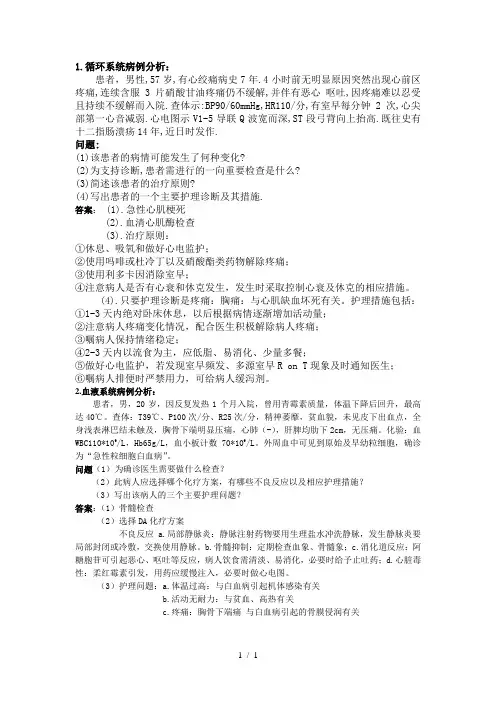
1.循环系统病例分析:患者,男性,57岁,有心绞痛病史7年.4小时前无明显原因突然出现心前区疼痛,连续含服3片硝酸甘油疼痛仍不缓解,并伴有恶心呕吐,因疼痛难以忍受且持续不缓解而入院.查体示:BP90/60mmHg,HR110/分,有室早每分钟2次,心尖部第一心音减弱.心电图示V1-5导联Q波宽而深,ST段弓背向上抬高.既往史有十二指肠溃疡14年,近日时发作.问题:(1)该患者的病情可能发生了何种变化?(2)为支持诊断,患者需进行的一向重要检查是什么?(3)简述该患者的治疗原则?(4)写出患者的一个主要护理诊断及其措施.答案:(1).急性心肌梗死(2).血清心肌酶检查(3).治疗原则:①休息、吸氧和做好心电监护;②使用吗啡或杜冷丁以及硝酸酯类药物解除疼痛;③使用利多卡因消除室早;④注意病人是否有心衰和休克发生,发生时采取控制心衰及休克的相应措施。
(4).只要护理诊断是疼痛:胸痛:与心肌缺血坏死有关。
护理措施包括:①1-3天内绝对卧床休息,以后根据病情逐渐增加活动量;②注意病人疼痛变化情况,配合医生积极解除病人疼痛;③嘱病人保持情绪稳定;④2-3天内以流食为主,应低脂、易消化、少量多餐;⑤做好心电监护,若发现室早频发、多源室早R on T现象及时通知医生;⑥嘱病人排便时严禁用力,可给病人缓泻剂。
2.血液系统病例分析:患者,男,20岁,因反复发热1个月入院,曾用青霉素质量,体温下降后回升,最高达40℃。
查体:T39℃、P100次/分、R25次/分,精神萎靡,贫血貌,未见皮下出血点,全身浅表淋巴结未触及,胸骨下端明显压痛,心肺(-),肝脾均肋下2cm,无压痛。
化验:血WBC110*109/L,Hb65g/L,血小板计数70*109/L。
外周血中可见到原始及早幼粒细胞,确诊为“急性粒细胞白血病”。
问题(1)为确诊医生需要做什么检查?(2)此病人应选择哪个化疗方案,有哪些不良反应以及相应护理措施?(3)写出该病人的三个主要护理问题?答案:(1)骨髓检查(2)选择DA化疗方案不良反应 a.局部静脉炎:静脉注射药物要用生理盐水冲洗静脉,发生静脉炎要局部封闭或冷敷,交换使用静脉。

病历分析试题及答案
1. 病历摘要:
患者,男性,45岁,因“反复胸痛1周,加重伴呼吸困难2小时”入院。
既往有高血压病史5年,未规律服药。
查体:BP 160/100mmHg,
心率90次/分,双肺呼吸音清,未闻及干湿性啰音。
心界向左下扩大,心律齐,心尖部可闻及3/6级收缩期吹风样杂音。
心电图示:V1-V5导联ST段抬高,T波倒置。
2. 问题:
(1) 根据患者临床表现,最可能的诊断是什么?
(2) 该患者需要进行哪些检查以明确诊断?
(3) 如何制定该患者的治疗方案?
3. 答案:
(1) 根据患者的胸痛症状、高血压病史、查体发现的心界扩大及心脏
杂音,最可能的诊断为急性心肌梗死。
(2) 该患者需要进行的检查包括:血常规、血生化、心肌酶谱、肌钙
蛋白I、心电图、心脏超声、冠状动脉造影等。
(3) 治疗方案应包括:立即给予阿司匹林、氯吡格雷、肝素等抗血小
板和抗凝治疗;稳定血压,必要时使用ACEI类药物;根据病情考虑是
否需要进行冠状动脉介入治疗;长期管理高血压,改善生活方式,定
期随访。

病理生理学病例分析题本页仅作为文档封面,使用时可以删除This document is for reference only-rar21year.March病理生理学病例分析题一、患者,男性,40岁,呕吐、腹泻伴发热、口渴、尿少4天入院。
体格检查:体温℃,血压110/80mmHg,汗少、皮肤黏膜干燥。
实验室检查:血Na+155mmol/L,血浆渗透压320mmol/L,尿比重>,其余化验检查基本正常。
立即给予静脉滴注5%葡萄糖溶液2500ml/d和抗生素等。
2天后除体温、尿量恢复正常和口不渴外,反而出现眼窝凹陷、皮肤弹性明显降低、头晕、厌食、肌肉软弱无力,肠鸣音减弱,腹壁反射消失。
浅表静脉萎陷,,脉搏110次/分,血压72/50mmHg,血Na+120mmol/L,血浆渗透压255mmol/L,血K+L,尿比重(尿相对密度)<,尿钠8mmol/L。
思考题:1.患者在治疗前和治疗后发生了何种水、电解质代谢紊乱为什么2.解释患者临床表现的病理生理学基础。
答题思路:患者呕吐、腹泻4天可导致大量消化液的丢失,消化液为等渗性液体,因伴有发热,患者经皮肤、呼吸道丢失水分增多,最终导致失水多于失钠;化验检查血Na+155mmol/L,血浆渗透压320mmol/L,都高于正常水平,因此,根据该患者治疗前的病因和血钠浓度及血浆渗透压水平判定发生的是高渗性脱水。
(1)患者治疗前有口渴、尿少(<400ml/d)。
(2)查体:体温℃,血压110/80mmHg,汗少、皮肤黏膜干燥。
(3)化验:血Na+155mmol/L,血浆渗透压320mmol/L,尿比重>.以上症状和体征均符合高渗性脱水的病理生理学变化。
该患者由于2天的治疗过程只补5%葡萄糖溶液而未补盐,将高渗性脱水转为了低渗性脱水。
(1)在治疗过程中,2天内静脉滴注5%葡萄糖溶液2500ml/d,即只补充水分而未补充钠盐,使病情发生改变,患者由高渗性脱水转为低渗性脱水。
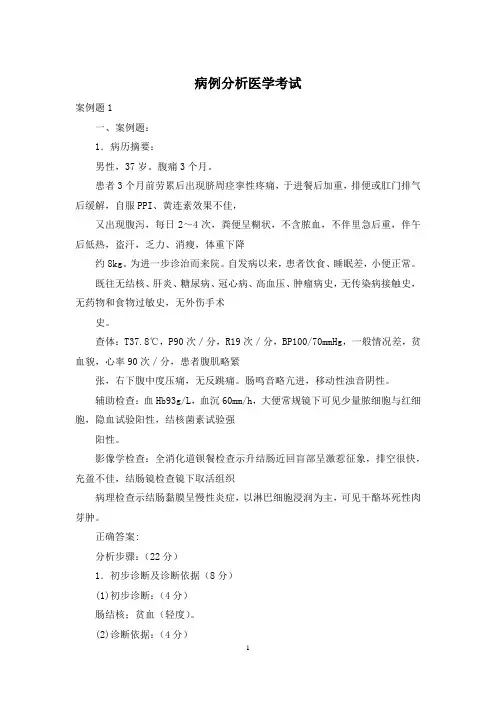
病例分析医学考试案例题1一、案例题:1.病历摘要:男性,37岁。
腹痛3个月。
患者3个月前劳累后出现脐周痉挛性疼痛,于进餐后加重,排便或肛门排气后缓解,自服PPI、黄连素效果不佳,又出现腹泻,每日2~4次,粪便呈糊状,不含脓血,不伴里急后重,伴午后低热,盗汗,乏力、消瘦,体重下降约8kg。
为进一步诊治而来院。
自发病以来,患者饮食、睡眠差,小便正常。
既往无结核、肝炎、糖尿病、冠心病、高血压、肿瘤病史,无传染病接触史,无药物和食物过敏史,无外伤手术史。
查体:T37.8℃,P90次/分,R19次/分,BP100/70mmHg,一般情况差,贫血貌,心率90次/分,患者腹肌略紧张,右下腹中度压痛,无反跳痛。
肠鸣音略亢进,移动性浊音阴性。
辅助检查:血Hb93g/L,血沉60mm/h,大便常规镜下可见少量脓细胞与红细胞,隐血试验阳性,结核菌素试验强阳性。
影像学检查:全消化道钡餐检查示升结肠近回盲部呈激惹征象,排空很快,充盈不佳,结肠镜检查镜下取活组织病理检查示结肠黏膜呈慢性炎症,以淋巴细胞浸润为主,可见干酪坏死性肉芽肿。
正确答案:分析步骤:(22分)1.初步诊断及诊断依据(8分)(1)初步诊断:(4分)肠结核;贫血(轻度)。
(2)诊断依据:(4分)①中年男性,慢性病程。
②腹痛、腹泻,伴有发热、盗汗、消瘦、乏力、体重下降3个月。
③既往体健。
④查体T37.8℃,贫血貌,右下腹中度压痛。
⑤辅助检查Hb93g/L,血沉60mm/h,结核菌素试验强阳性。
钡餐可见回盲部激惹征,结肠镜检查示结肠黏膜呈慢性炎症,淋巴细胞为主,可见于酪坏死性肉芽肿。
2.鉴别诊断(6分)①Crohn病:病程多较长,无结核中毒症状,PPD试验一般不呈强阳性,结肠镜表现为节段性病变,病理示非干酪坏死性肉芽肿。
②阿米巴病:多有感染史,或疫水接触史,粪便镜检可见阿米巴滋养体。
③右侧结肠癌:多见于老年人,钡餐可见充盈缺损,结肠镜+病理活检可证实。
3.进一步检查(4分)①肝肾功能。
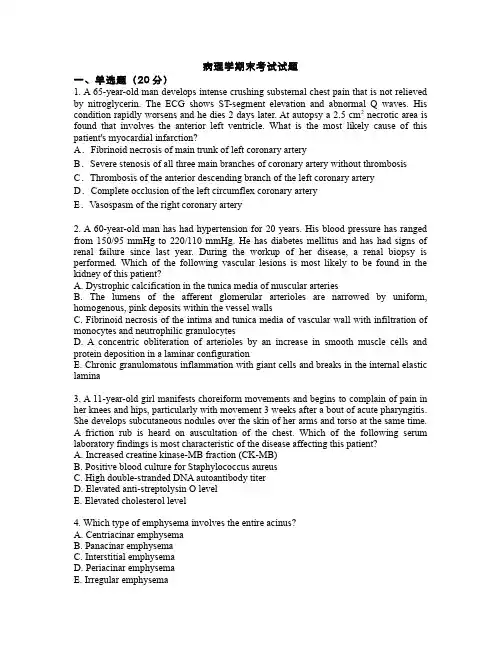
病理学期末考试试题一、单选题(20分)1. A 65-year-old man develops intense crushing substernal chest pain that is not relieved by nitroglycerin. The ECG shows ST-segment elevation and abnormal Q waves. His condition rapidly worsens and he dies 2 days later. At autopsy a2.5 cm2 necrotic area is found that involves the anterior left ventricle. What is the most likely cause of this patient's myocardial infarction?A.Fibrinoid necrosis of main trunk of left coronary arteryB.Severe stenosis of all three main branches of coronary artery without thrombosis C.Thrombosis of the anterior descending branch of the left coronary artery D.Complete occlusion of the left circumflex coronary arteryE.V asospasm of the right coronary artery2. A 60-year-old man has had hypertension for 20 years. His blood pressure has ranged from 150/95 mmHg to 220/110 mmHg. He has diabetes mellitus and has had signs of renal failure since last year.During the workup of her disease,a renal biopsy is performed. Which of the following vascular lesions is most likely to be found in the kidney of this patient?A. Dystrophic calcification in the tunica media of muscular arteriesB.The lumens of the afferent glomerular arterioles are narrowed by uniform, homogenous, pink deposits within the vessel wallsC. Fibrinoid necrosis of the intima and tunica media of vascular wall with infiltration of monocytes and neutrophilic granulocytesD. A concentric obliteration of arterioles by an increase in smooth muscle cells and protein deposition in a laminar configurationE. Chronic granulomatous inflammation with giant cells and breaks in the internal elastic lamina3. A 11-year-old girl manifests choreiform movements and begins to complain of pain in her knees and hips, particularly with movement 3 weeks after a bout of acute pharyngitis. She develops subcutaneous nodules over the skin of her arms and torso at the same time.A friction rub is heard on auscultation of the chest. Which of the following serum laboratory findings is most characteristic of the disease affecting this patient?A. Increased creatine kinase-MB fraction (CK-MB)B. Positive blood culture for Staphylococcus aureusC. High double-stranded DNA autoantibody titerD. Elevated anti-streptolysin O levelE. Elevated cholesterol level4. Which type of emphysema involves the entire acinus?A. Centriacinar emphysemaB. Panacinar emphysemaC. Interstitial emphysemaD. Periacinar emphysemaE. Irregular emphysema5. Which of the followings is not involved in emphysema lesions?A. Terminal bronchiolesB. AlveoliC. Alveolar tubeD. Respiratory bronchioleE. Alveolar sacs6. A 60-year-old woman develops a chronic cough with white foamy mucous sputum in autumn and winter each year, which continues for about three months each time. Which of the following pathologic conditions is not associated with these clinical findings?A. Fibroelastosis of the bronchial wallB. Hyperplasia of goblet cells in mucosal epitheliumC. Hypertrophy of mucous glandsD. Degeneration and atrophy of bronchial cartilageE. Squamous metaplasia of bronchial mucosa7. A 44-year-old man has been feeling fatigued for the past 4 months. He remembers that he had jaundice about 10 years ago, but that resolved 2 months later and he has been healthy since. On physical examination there are no remarkable findings. Laboratory studies show his hemoglobin is 14.0 g/dL. A chemistry panel reveals normal serum electrolytes, but he has a decreased level of total protein and albumin, an increased level of ALT and AST, as well as a slightly elevated level of total bilirubin and direct bilirubin.A liver biopsy is performed and microscopic examination shows disruption of the limiting plate of hepatocytes with extension of inflammation into the lobules from the triads. There is focal ballooning degeneration of hepatocytes. Which of the following laboratory test findings is most characteristic of his disease?A. Increased serum alpha fetoproteinB. Positive hepatitis B surface antibodyC. Positive hepatitis B surface antigenD. Positive hepatitis B core antigenE. Positive hepatitis A antigen8. A 55-year-old man has experienced severe epigastric pain, vomiting, and a 10-kg weight loss over the past3months.Physical examination reveals fixed left supraclavicular lymphadenopathy. Upper gastrointestinal endoscopy is done and confirms the present of a moderately differentiated adenocarcinoma. A palliative operation is performed to relieve his symptoms. A 6-cm ulcerative mass is located in the gastric antrum.The tumor has penetrated through the gastric wall, and is adherent to the transverse colon. The liver appears normal. There are numerous small white nodules on the serosal surface of intestine, spleen and peritoneum. Which of the following conditions may not have occurred in this patient’s tumor?A. Local invasionB. Lymphatic spreadC. Hematogenous spreadD. Seeding within abdominal cavityE. Perforation9. One week after a mild flu like illness, a 9-year-old boy has an episode of hematuria that subsides within 2 days. One month later, he tells his parents that his urine is red again. On physical examination, there are no significant findings. Urinalysis shows l+ proteinuria, l+ hematuria, and no ketones, glucose, or urobilinogen. The serum urea nitrogen level is 36 mg/dL and the creatinine level is 32 mg/dL. A renal biopsy specimen shows diffuse mesangial proliferation and electron-dense deposits in the mesangium. Which of the following mechanisms is most likely to produce these findings?A. Deposition of immune complexes containing IgAB. Formation of antibodies against type IV collagenC. Virus-mediated injury to the glomeruliD. Cytokine-mediated injury to the capillariesE. Congenital defects in the structure of glomerular basement membranes10. A 3-year-old girl is brought to the clinic by her parents who are very concerned about her.Physical examination is remarkable for extremity edema.Urinalysis shows significant proteinuria, but no red cells or casts. Electron microscopy performed on a kidney biopsy would be most likely to show which of the following findings?A. Subepithelial spikesB. Subendothelial depositsC.Mesangial depositsD.Fusion of epithelial foot processesE.Dense deposits11. A 60-year-old man develops low back pain, and radiologic investigation reveals multiple osteoblastic lesions of the lumbar vertebrae. A hard, irregular nodule on the posterior surface of the prostate is found on rectal examination. Plasma levels of prostatic specific antigen (PSA) are markedly increased. Which of the following is the most likely diagnosis?A.Prostatic hyperplasiaB. Multiple myelomaC. Prostatic intraepithelial neoplasia (PIN)D.Chronic prostatitisE.Prostatic adenocarcinoma12. An 18-year-old woman has had pelvic discomfort for several months. On pelvic examination, there is a 10-cm right adnexal mass. Upon surgical resection, the mass is solid and white,with small areas of necrosis.Microscopically,it contains mostly primitive mesenchymal cells along with some cartilage,muscle,and foci of neuroepithelial differentiation. Which of the following is the most likely diagnosis? A.Brenner tumorB. DysgerminomaC. Granulosa cell tumorD.Immature teratomaE.Leiomyosarcoma13. The most common histologic type of cancer in cervix is aA.Squamous carcinomaB.Mucinous carcinomaC.Papillary carcinomaD.LymphomaE.Leiomyosarcoma14. Which of the following lymphomas is a mature T-cell lymphoma?A.T lymphoblastic leukemia/lymphomaB.Mycosis fungoidesC. Mantle cell lymphomaD.Follicular lymphomaE.Burkitt lymphoma15. The microscopic appearance of a neoplasm in the jaw bones of an 8-year-old boy shows a “starry sky” pattern. The tumor cells express CD19, CD20 and CD10. Genetic examination shows t(8;14)(q24;q32).Which of the following is the most likely diagnosis?A.Burkitt lymphomaB.Diffuse large B-cell lymphomaC.Eosinophilic granulomaD.Mycosis fungoidesE.Follicular lymphoma16. Which of the following regarding follicular lymphoma is incorrect?A. Originates from marginal zone cellsB. Usually has a nodal patternC. It is an indolent neoplasmD. Can transform into a diffuse large B-cell lymphomaE. May occur primarily in the skin, GI tract, breast and testis17. Which of the following secretes calcitonin?A. Follicular carcinomaB. Papillary carcinomaC. Medullary carcinomaD. Squamous cell carcinomaE. Undifferentiated carcinoma18. An 8-month-old infant is being evaluated for growth and mental retardation. Physical examination reveals this small infant with dry,rough skin,a protuberant abdomen, periorbital edema, a flattened, broad nose, and a large, protuberant tongue. Which of thefollowing disorders is the most likely cause of this infant's signs and symptoms?A. Graves' diseaseB. CretinismC. Toxic multinodular goiterD. Toxic adenomaE. Struma ovary19. A 65-year-old man presents with tremors at rest and muscular rigidity. Physical examination reveals the patient has a "masklike" face. In this patient, from which one of the following sites would biopsies most likely reveal intracytoplasmic eosinophilic inclusions within neurons?A. Basal gangliaB. Caudate nucleusC. HippocampusD. MidbrainE. Substantia nigra20. Which of the following is the major component of senile plaque?A. neurofilamentsB. microtubule proteinC. β-amyloid substanceD. glial filament acid proteinE. S-100 protein二、名词解释 (20分)1. Atherosclerosis 6. Cervical intraepithelial neoplasia CIN2. Silicosis7. Reed-Sternberg cell3. COPD8. Red neuron4. Viral hepatitis9. Teratoma5. Pseudolobule10. Caseous pneumonia三、简答题 (40分)1. 何谓肺心病?简述其病因及发病机制。
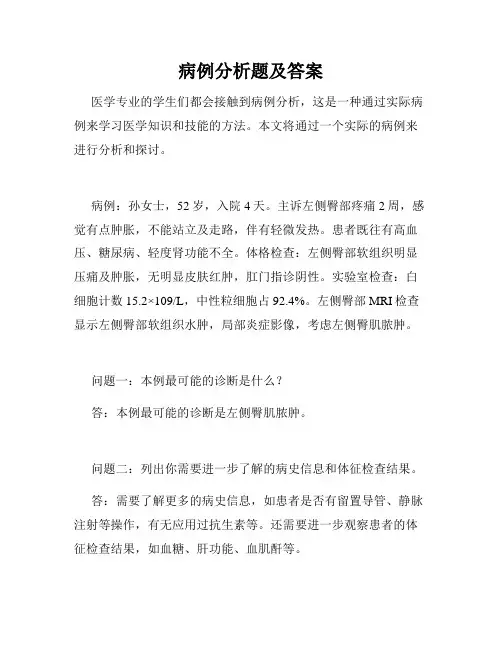
病例分析题及答案医学专业的学生们都会接触到病例分析,这是一种通过实际病例来学习医学知识和技能的方法。
本文将通过一个实际的病例来进行分析和探讨。
病例:孙女士,52岁,入院4天。
主诉左侧臀部疼痛2周,感觉有点肿胀,不能站立及走路,伴有轻微发热。
患者既往有高血压、糖尿病、轻度肾功能不全。
体格检查:左侧臀部软组织明显压痛及肿胀,无明显皮肤红肿,肛门指诊阴性。
实验室检查:白细胞计数15.2×109/L,中性粒细胞占92.4%。
左侧臀部MRI检查显示左侧臀部软组织水肿,局部炎症影像,考虑左侧臀肌脓肿。
问题一:本例最可能的诊断是什么?答:本例最可能的诊断是左侧臀肌脓肿。
问题二:列出你需要进一步了解的病史信息和体征检查结果。
答:需要了解更多的病史信息,如患者是否有留置导管、静脉注射等操作,有无应用过抗生素等。
还需要进一步观察患者的体征检查结果,如血糖、肝功能、血肌酐等。
问题三:你如何进一步诊断和治疗患者?答:可以考虑进行穿刺抽取脓液或手术切开引流,并对患者进行抗生素治疗。
根据细菌培养和药敏试验结果进行选择抗生素的种类和用药方案。
并继续监测患者病情及治疗效果。
问题四:如何评估患者的预后?答:预后评估与治疗方案选择、病情严重程度及并发症等因素有关。
在治疗过程中应注意观察病情变化及出现并发症的情况。
如有必要,可根据患者实际情况进行相关检查和治疗措施。
预后评估的重要指标包括感染根除率、恢复时间和生存率等。
病例分析是医学专业学习的基础,通过深入掌握和分析实际病例,可以更好地掌握疾病的诊断和治疗方法,提高诊疗水平和临床实践能力。
当然,在实践操作中也要遵循医学伦理和法律规定,为患者提供优质的医疗服务。

病理生理学》病案分析试题一、病例思考(水电)患者女性,16岁,因心慌、气短1年,咳嗽、咯血、腹胀和尿少2周入院。
入院后经各种检查诊断为:风湿性心脏瓣膜病,心功能Ⅳ级,肺部感染。
实验室检查:血K+4.6m mol/L,Na+144mmo l/L,C l-90m mol/L,HCO-329m mol/L。
住院后给予强心、利尿(氢氯噻嗪25m g/次,3次/日)、抗感染治疗,并进低盐食物。
治疗7天后,腹胀、下肢浮肿基本消失,心衰明显改善。
治疗18天后,心衰基本控制,但一般状况无明显改善,且出现精神萎靡不振、嗜唾、全身软弱无力、腹胀、恶心、呕吐、不思进食及尿少等,并有脱水现象;血K+2.9mmol/L,Na+112mm ol/L,Cl-50.9mmo l/L,H CO-335.7m mol/L。
立即给予静脉补充含氯化钾的葡萄糖盐水。
5天后,一般状况明显好转,食欲增加,肌张力恢复,尿量亦逐渐正常;血K+4.4mmol/L,Na+135mm ol/L,Cl-91mmol/L,HCO-330mmol/L。
讨论题:1、引起患者出现低血钾、低血钠的原因有哪些?2、哪些症状与低血钾有关?说明其理由。
为什麽需补钾5天后病情才好转?3、患者是否合并酸碱平衡紊乱?是何原因引起?为何种类型?二、病例思考(酸碱)限于篇幅,不再另加病例。
病例一、二、和三分别见A型选择题30、31和32。
请分别分析这些患者体内的酸碱平衡状况。
病例一、某慢性肺气肿患者,血气分析及电解质测定结果如下:pH7.40,P aCO28.9k Pa(67mmHg),[HCO-3]40mmol/L,[N a+]140mmol/L,[C l-]90mmol/L.病例二:某慢性肾功能不全患者,因上腹部不适呕吐而急诊入院,血气分析及电解质测定结果如下:pH7.40,PaC O25.9kPa(44mmHg), [H CO3-]26mmo l/L,[Na+]142mm ol/L,[Cl-]96m mol/L。
1、[病例纲要]女性, 59 岁,中断咳嗽、咳痰 5 年,加重伴咯血 2 个月。
患者 5 年前受凉后低热、咳嗽、咳白色粘痰,赐予抗生素及祛痰治疗, 1 个月后症状不见好转,体重渐渐降落,后拍胸片诊为“浸润型肺结核”,肌注链霉素 1 个月,口服利福平、雷米封 3 个月,症状渐渐减少,遂自行停药,今后向来咳嗽,少许白痰,未再复查胸片。
2 个月前劳苦后咳嗽加重,少许咯血伴低热、盗汗、胸闷、乏力又来诊。
病后进食少,二便正常,睡眠稍差。
既往 6 年前查出血糖高,中断用过降糖药,无药物过敏史。
查体: T37.4 ℃,P94 次 / 分, R22 次/ 分, BP130/80mmHg,一般稍弱,无皮诊,浅表淋巴结未涉及,巩膜不黄,气管居中,两上肺呼吸音稍减低,并闻及少许湿罗音,心叩不大,心率 94 次 / 分,律齐,无杂音,腹部平软,肝脾未涉及,下肢不肿。
化验:血 HGB 110g/L, WBC 4.5 × 109/L, N 53%, L47%, PLT 210× 109/L, ESR 35mm/h,空肚血糖,尿蛋白(-),尿糖(3+)一、诊疗及诊疗依照(4 分 )二、鉴识诊疗分)三、进一步检查分)四、治疗原则 (3 分 )2、[病例纲要]男性, 65 岁,连续心前区痛 4 小时。
4 小时前即午餐后突感心前区痛,伴左肩臂酸胀,自含硝酸甘油 1 片未见好转,伴憋气、乏力、出汗,二便正常。
既往高血压病史 6 年,最高血压160/100mmHg,未规律治疗,糖尿病病史5 年,向来口服降糖药物治疗,无药物过敏史,抽烟10年,每天20支左右,不喝酒。
查体: T37℃, P100 次 / 分, R24 次 / 分, Bp150/90mmHg,半卧位,无皮疹及出血点,全身浅表淋奉承不大,巩膜无黄染,口唇稍发绀,未见颈静脉怒张,心叩不大,心律100 次/ 分,律齐,心尖部Ⅱ /6级缩短期吹风样杂音,两肺叩清,两肺底可闻及渺小湿罗音,腹平软,肝脾未及,双下肢不肿。
《病例分析》试题答案病历分析试题、答案及评分标准1病历分析例题-右额颞急性硬膜外血肿[病例摘要]男性,23岁,因骑车进行中被汽车撞倒,右颞部着地半小时,到急诊就诊患者摔倒后曾有约5分钟的昏迷,清醒后,自觉头痛,恶心。
体检:BP 139-80mmHg,P80次/分,一般情况可,神经系统检查未见阳性体征。
头颅平片提示:右额颞线形骨折。
遂将患者急诊留观。
在随后2小时中,患者头疼逐渐加重,伴呕吐,烦燥不安,进而出现意识障碍。
体检:T 38℃,BP 160/100mmHg,P60次/分,R18次/分,浅昏迷,左侧瞳孔3mm,对光反射存在,右侧瞳孔4mm,对光反应迟钝。
左鼻唇沟浅,左侧Babinski's Sign阳性。
[分析]一、诊断及诊断依据(8分)(一)诊断右额颞急性硬膜外血肿(二)诊断依据1.有明确的外伤史2.有典型的中间清醒期3.头部受力点处有线形骨折4.出现进行性颅内压增高并脑疝二、鉴别诊断(5分)1.急性硬膜下血肿及颅内血肿:同有外伤史;血肿多出现于对冲部位;意识障碍持续加重;明确诊断靠CT三、进一步检查(4分) 头颅CT平扫四、治疗原则(3分) 急诊行开颅血肿清除术2右髋关节后脱位[病例摘要]男性,40岁,右髋外伤后疼痛,不能活动四小时四小时前患者乘公共汽车,左下肢搭于右下肢上,突然急刹车,右膝顶撞于前座椅背上,即感右髋部剧痛,不能活动。
遂来院诊治。
患者身体素健。
无特殊疾病,无特殊嗜好。
骨科情况:仰卧位,右下肢短缩,右髋呈屈曲内收内旋畸形。
各项活动均受限。
右大粗隆上移。
右膝踝及足部关节主动被动活动均可,右下肢感觉正常。
[分析]一、诊断及诊断依据(8分)(一)诊断右髋关节后脱位(二)诊断依据1.典型的受伤机制2.大粗隆上移3.典型的右下肢畸形表现4.右下肢其它关节功能正常,感觉正常,说明未合并坐骨神经损伤二、鉴别诊断(5分)1.股骨颈骨折和转子间骨折(骨折机制走路滑倒时,身体扭转倒地所致患肢短缩,患髋呈屈曲内收外旋畸形)三、进一步检查(4分)右髋正侧位X线片可证实脱位,并了解脱位情况及有无合并骨折四、治疗原则(3分)1.无骨折或只有小片骨折的单纯性后脱位,应手法复位,皮索引固定2.如髋臼后缘有大块骨折或粉碎骨折或股骨头骨折,属复杂性后脱位,目前主张早期手术治疗,切开腹位与内固定3右肱骨髁上骨折[病例摘要]女性,6岁。
病例分析题第一篇:病例分析题《病理生理学》病案分析试题一、病例思考(水电)患者女性,16岁,因心慌、气短1年,咳嗽、咯血、腹胀和尿少2周入院。
入院后经各种检查诊断为:风湿性心脏瓣膜病,心功能Ⅳ级,肺部感染。
实验室检查:血+K4.6mmol/L,Na+144mmol/L,Cl-90mmol/L,HCO-329mmol/L。
住院后给予强心、利尿(氢氯噻嗪25mg/次,3次/日)、抗感染治疗,并进低盐食物。
治疗7天后,腹胀、下肢浮肿基本消失,心衰明显改善。
治疗18天后,心衰基本控制,但一般状况无明显改善,且出现精神萎靡不振、嗜唾、全身软弱无力、腹胀、恶心、呕吐、不思进食及尿少等,并有脱水现象;血K+2.9mmol/L,Na+112mmol/L,Cl-50.9mmol/L,HCO-335.7mmol/L。
立即给予静脉补充含氯化钾的葡萄糖盐水。
5天后,一般状况明显好转,食欲增加,肌张力恢复,尿量亦逐渐正常;血K+4.4mmol/L,Na+135mmol/L,Cl-91mmol/L,HCO-330mmol/L。
讨论题:1、引起患者出现低血钾、低血钠的原因有哪些?2、哪些症状与低血钾有关?说明其理由。
为什麽需补钾5天后病情才好转?3、患者是否合并酸碱平衡紊乱?是何原因引起?为何种类型?二、病例思考(酸碱)病例一、某慢性肺气肿患者,血气分析及电解质测定结果如下:pH7.40,PaCO2 8.9kPa(67mmHg),[HCO-3]40mmol/L,[Na+]140mmol/L,[Cl-]90mmol/L.病例二:某慢性肾功能不全患者,因上腹部不适呕吐而急诊入院,血气分析及电解质测定结果如下:pH7.40,PaCO25.9kPa(44mmHg), [HCO3-]26mmol/L, [Na+]142mmol/L, [Cl-]96mmol/L。
病例三:某重症肺心病伴下肢浮肿患者应用速尿治疗两周后,作血气分析及电解质测定,结果如下:pH7.34,PaCO2 8.8kPa(66mmHg),[HCO3-]36mmol/L,[Na+]140mmol/L,[Cl-]75mmol/L.三、病例思考(缺氧)患者女性,45岁,菜农。
《外科学》期末复习病例分析题(一).病例摘要:女性,39岁,烦燥不安、畏热、消瘦2月余. 患者于2月前因工作紧张,烦燥性急,常因小事与人争吵,难以自控。
着衣不多,仍感燥热多汗,在外就诊服用安神药物,收效不十分明显。
发病以来饭量有所增加,体重却较前下降。
睡眠不好,常需服用安眠药。
成形大便每日增为2次,小便无改变,近2月来月经较前量少。
既往体健,无结核或肝炎病史,家族中无精神病或高血压患者。
查体:T37.2℃,P92次/分,R20次/分,Bp 130/70mmHg。
发育营养可,神情稍激动,眼球略突出,眼裂增宽,瞬目减少。
两叶甲状腺可及、轻度肿大、均匀,未扪及结节,无震颤和杂音,浅表淋巴结不大,心肺(-)腹软,肝脾未及。
1.诊断及诊断依据;2.进一步检查;3.鉴别诊断;4.治疗原则?(二).病例摘要:男性,27岁,10分钟前左上胸部被汽车撞伤,既往体健.查体:Bp 80/50mmHg,脉搏148次/分,R:40次/分。
神清合作,痛苦状,呼吸急促,吸氧下呼吸紧迫反而加重,伴口唇青紫,颈静脉怒张不明显。
气管移向右侧。
左胸廓饱满,呼吸运动较右胸弱。
左胸壁有骨擦音(第4,5,6肋)局部压痛明显。
皮下气肿。
上自颈部、胸部直至上腹部均可触及皮下气肿。
左胸叩鼓,呼吸音消失,未闻及罗音,右肺呼吸者较粗,未闻及罗音。
左心界叩诊不清,心律整,心率:148次/分,心音较弱,未闻及杂音。
腹部平软,无压痛肌紧张,肠鸣音正常,肝脾未及,下肢无浮肿,四肢活动正常,未引出病理反射。
1.诊断及诊断依据;2.进一步检查;3.鉴别诊断;4.治疗原则?(三).病史摘要:患者因高处坠落右前胸先着地,伤后即感胸痛,呼吸困难,查体见明显呼吸困难口唇发绀,即16/6KPa(82.5/45mmHg),脉搏细弱,气管明显左移,颈静脉怒张,左胸第3,4肋及胸骨柄下方有一约6×9厘米大小皮下瘀斑,压痛明显,未扪及骨折断端,左胸叩为高清音,左肺呼吸音明显降低,心率130次/分,心音弱,腹部(一)。
病例分析题一:男性,55岁,胸骨后压榨性痛,伴恶心、呕吐2小时患者于2小时前搬重物时突然感到胸骨后疼痛,压榨性,有濒死感,休息与口含硝酸甘油均不能缓解,伴大汗、恶心,呕吐过两次,为胃内容物,二便正常。
既往无高血压和心绞痛病史,无药物过敏史,吸烟20余年,每天1包查体:T36.8℃, P100次/分,R20次/分,BP100/60mmHg,急性痛苦病容,平卧位,无皮疹和紫绀,浅表淋巴结未触及,巩膜不黄,颈软,颈静脉无怒张,心界不大,心率100次/分,有期前收缩5-6次/分,心尖部有S4,肺清无罗音,腹平软,肝脾未触及,下肢不肿。
心电图示:STV1-5升高,QRS V1-5呈Qr型,T波倒置和室性早搏。
[分析]一、诊断及诊断依据(8分)(一)诊断:冠心病急性前壁心肌梗死室性期前收缩心功能Ⅰ级(二)诊断依据:1. 典型心绞痛而持续2小时不缓解,休息与口含硝酸甘油均无效,有吸烟史(危险因素)2. 心电图示急性前壁心肌梗死,室性期前收缩3. 查体心叩不大,有期前收缩,心尖部有S4二、鉴别诊断(5分)1. 夹层动脉瘤2. 心绞痛3. 急性心包炎三、进一步检查(4分)1. 继续心电图检查,观察其动态变化2. 化验心肌酶谱3. 凝血功能检查,以备溶栓抗凝治疗4. 化验血脂、血糖、肾功5.有条件时首先考虑冠状动脉造影与介入性治疗,恢复期可行运动核素心肌显像、Holter、超声心动图检查,找出高危因素,四、治疗原则(3分)1. 绝对卧床休息3-5天,持续心电监护,低脂半流食,保持大便通畅2. 溶栓治疗:发病6小时内,无出凝血障碍及溶栓禁忌证,可用尿激酶、链激酶或t-PA溶栓治疗;抗凝治疗:溶栓后用肝素静滴,口服阿司匹林3.有条件时及时行介入治疗4. 吸氧,解除疼痛:哌替啶或吗啡,静滴硝酸甘油;消除心律失常:利多卡因病例分析题二女性,60岁,上腹痛2天2 天前进食后1小时上腹正中隐痛,逐渐加重,呈持续性,向腰背部放射,仰卧、咳嗽或活动时加重,伴低热、恶心、频繁呕吐,吐出食物、胃液和胆汁,吐后腹痛无减轻,多次使用止痛药无效。
患儿,女,7个月,因发热2天伴惊厥2次入院。
2天前始发热,体温40。
C,次日有喷射性呕吐,精神软,胃纳差,下午出现惊厥,共2次,为四肢小抽动,历时1-2分钟,抽后嗜睡状,故转来本院。
病前无皮肤破损。
已接种BCG。
体检:T 39。
C,P 120次/分,R 30次/分,Wt 7Kg,头围44cm, 前囟2×2.5cm,隆起,心肺听诊无殊,肝肋下2cm,腹壁皮下脂肪0.9cm, 颈有抵抗,克氏征(+),布氏征(+),巴氏征(+)。
血常规:WBC 20×109/L,N80%,L20%; CSF:外观微混,蛋白(++),WBC1500×106/L,N60%,L40%,糖L。
问题:1).该患儿的诊断是什么(2分) 2).该病确诊的依据是什么(2分) 3).简述该病治疗方案。
(3分)1).答:化脓性脑膜炎(2分)。
2).答:CSF涂片找到细菌(1分)或培养阳性(1分)。
3).答:化脓性脑膜炎治疗方案:①抗生素治疗(1分);②对症支持治疗,包括退热、止惊、降颅压等治疗(1分);③观察生命体征及是否出现并发症并及时处理(1分)。
患儿女,8月。
因发热3天,抽搐1次入院。
查体:嗜睡,T 39℃,前囟紧张,颈抵抗,布氏征(+),克氏征(+),双侧巴氏征(+)。
血常规:WBC 20×109/L,N80%,L20%,PLT167×109/L,Hb98g/L。
CRP100mg/L。
脑脊液:WBC 3060×106/L,N87%,糖L,氯化物125mmol/L,蛋白1.5g/L。
入院后予头孢曲松抗感染后病情好转,体温下降,精神转好。
入院第7天患儿体温再次升高至39.5℃,伴抽搐1次,查体示前囟隆起。
复查脑脊液示WBC 15×106/L,N33 %,蛋白0.4g/L。
问题: 1)写出该患儿的完整诊断。
(2分) 2)进一步需完善哪些检查(2分) 3)简述此患儿的治疗计划。
1.循环系统病例分析:
患者,男性,57岁,有心绞痛病史7年.4小时前无明显原因突然出现心前区疼痛,连续含服3片硝酸甘油疼痛仍不缓解,并伴有恶心呕吐,因疼痛难以忍受且持续不缓解而入院.查体示:BP90/60mmHg,HR110/分,有室早每分钟2次,心尖部第一心音减弱.心电图示V1-5导联Q波宽而深,ST段弓背向上抬高.既往史有十二指肠溃疡14年,近日时发作.
问题:
(1)该患者的病情可能发生了何种变化?
(2)为支持诊断,患者需进行的一向重要检查是什么?
(3)简述该患者的治疗原则?
(4)写出患者的一个主要护理诊断及其措施.
答案:(1).急性心肌梗死
(2).血清心肌酶检查
(3).治疗原则:
①休息、吸氧和做好心电监护;
②使用吗啡或杜冷丁以及硝酸酯类药物解除疼痛;
③使用利多卡因消除室早;
④注意病人是否有心衰和休克发生,发生时采取控制心衰及休克的相应措施。
(4).只要护理诊断是疼痛:胸痛:与心肌缺血坏死有关。
护理措施包括:
①1-3天内绝对卧床休息,以后根据病情逐渐增加活动量;
②注意病人疼痛变化情况,配合医生积极解除病人疼痛;
③嘱病人保持情绪稳定;
④2-3天内以流食为主,应低脂、易消化、少量多餐;
⑤做好心电监护,若发现室早频发、多源室早R on T现象及时通知医生;
⑥嘱病人排便时严禁用力,可给病人缓泻剂。
2.血液系统病例分析:
患者,男,20岁,因反复发热1个月入院,曾用青霉素质量,体温下降后回升,最高达40℃。
查体:T39℃、P100次/分、R25次/分,精神萎靡,贫血貌,未见皮下出血点,全身浅表淋巴结未触及,胸骨下端明显压痛,心肺(-),肝脾均肋下2cm,无压痛。
化验:血WBC110*109/L,Hb65g/L,血小板计数70*109/L。
外周血中可见到原始及早幼粒细胞,确诊为“急性粒细胞白血病”。
问题(1)为确诊医生需要做什么检查?
(2)此病人应选择哪个化疗方案,有哪些不良反应以及相应护理措施?
(3)写出该病人的三个主要护理问题?
答案:(1)骨髓检查
(2)选择DA化疗方案
不良反应 a.局部静脉炎:静脉注射药物要用生理盐水冲洗静脉,发生静脉炎要局部封闭或冷敷,交换使用静脉。
b.骨髓抑制:定期检查血象、骨髓象;c.消化道反应:阿糖胞苷可引起恶心、呕吐等反应,病人饮食需清淡、易消化,必要时给予止吐药;d.心脏毒性:柔红霉素引发,用药应缓慢注入,必要时做心电图。
(3)护理问题:a.体温过高:与白血病引起机体感染有关
b.活动无耐力:与贫血、高热有关
c.疼痛:胸骨下端痛与白血病引起的骨膜侵润有关。